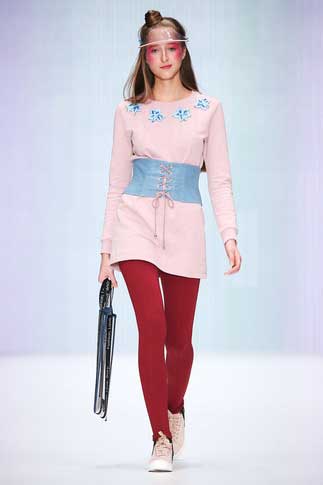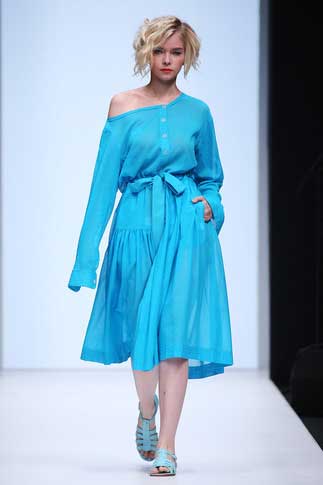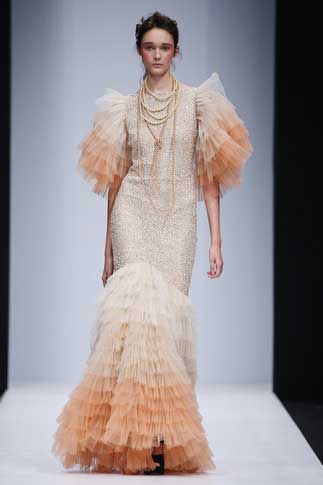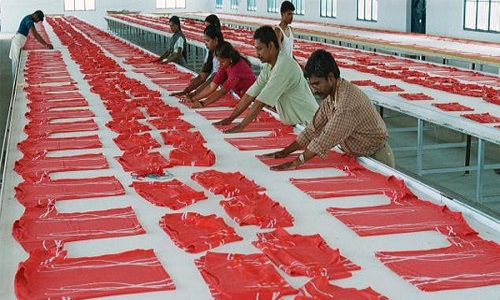FW
India has new duty drawback rates on garment exports from October 1, 2017. Duty drawback can be understood as the refund of the duty that was paid for the imported raw material used in the production of the exported products to the exporter.
Sustained export growth is essential to maintain and accelerate GDP growth, increase employment and reduce poverty. To encourage exports, duty drawbacks are offered to exporters, which will make their products more competitive in overseas markets.
For goods that have been imported in the country, on payment of duty, and then are being exported within a specified time period, the customs duty paid for the product import can be claimed as the duty drawback with certain cuts. The duty drawback scheme provides a rebate of the duty that is chargeable on the imported or excisable goods used in manufacturing of the exported product.
However, Indian garment exporters are already facing severe competition globally from countries like Bangladesh, Sri Lanka, Cambodia, and Vietnam. This rate cut is going to further elevate the costs of Indian garments, which will push Indian exports further back. Since 80 per cent of garment units in country belong to the small and medium category, this rate cut is expected to lead to huge job losses.
Lenzing has launched Refibra, a cellulosic fiber made from chemically recycled material that includes post-industrial cotton scraps and wood. Dubbed as the new generation of Tencel, Refibra is Recycled Claim Standard–certified and is made using a process that allows companies to identify the Refibra fiber in a finished garment. This guarantees transparency in the overall processing chain. For customers it is important to know whether the fiber made from recycled material is really in the textiles they have purchased.
At the October Kingpins Amsterdam, denim designer Adriano Goldschmied introduced a denim capsule collection made with Refibra. The capsule collection features 15 women’s and men’s styles.
Goldschmied has been designing denim since 1972, and he has been working with Tencel since the 1990s. He has long been an advocate for product development in the denim industry with less impact on the environment without compromising consumer demand for comfort and fashion.
Refibra fibers are made from pulp that contains cotton scraps left over from cutting operations and wood. The fibers are produced in the lyocell production process. Worldwide, Lenzing is the first manufacturer to offer cellulose fibers featuring recycled material on a commercial scale and is a pioneer with this technology. Reducing the need to extract additional raw materials from nature lowers the impact on natural resources. Thus Refibra fibers have initiated an important step towards circular economy for textiles.
Pakistan’s hosiery manufacturers and exporters say the delay in restoring zero rate regime is holding back textile makers from modernizing their industrial units. They want the zero rate regime for five export sectors. Industrial units face high power, gas and water rates.
A reduction in inputs costs is a long running demand of the country’s value-added textile exporters. They say this will help make Pakistan's exports competitive on world markets. Instead the soaring cost of inputs is hindering the country’s apparel textile growth. One point exporters make is the minimum wage in Pakistan is 111 per cent higher than in Bangladesh. A 20 per cent reduction would enable Pakistani exporters to compete with regional competitors. Similarly gas rates for the textile sector should also be reduced by 20 per cent.
A 0.25 per cent Export Development Surcharge is imposed on export proceeds. Exporters say the EDF should be placed on luxury imported goods like cars, soaps, shampoos, cosmetics and finished items and should be abolished from exports. Apparel textile makers want freedom to import yarn, fabric and other key raw materials. They say a four per cent incentive should be given on indirect exports of yarn/local sale on domestic markets.
In the second quarter of 2017, global yarn production rose by 11 per cent. It increased in Asia, Europe, and Brazil and slightly declined in the US. The growth drivers are: Asia and Brazil with their respective 12 per cent and 11 per cent increases. Yarn production decreased by 10 per cent in the US and by 18 per cent in Africa since the first quarter of 2017.
Global fabric production improved by almost nine per cent in the second quarter of 2017, with the most significant increase in Brazil, Asia, and Africa (10.4 per cent, 9.8 per cent and 9.2 per cent respectively). The output in the US and Europe remained stable. The situation has improved compared to the same period last year, with an increase of global fabric output of almost four per cent.
Global yarn stocks have also improved compared to the same quarter a year earlier. Global yarn orders have fallen in all regions in the second quarter of 2017. Worldwide fabric stocks increased a little, with the most significant change observed in Brazil for the second quarter in a row. Asian and European fabric orders remained stable and rose in Brazil and Africa. In comparison to the second quarter of last year, Asian and Brazilian fabric orders declined significantly, while they slightly increased in Europe and Africa.
Eastman has launched Naia, a sustainable fiber with easy-care attributes. The fiber is made from wood pulp from fast-growing pine and eucalyptus trees sourced from certified forests. Eastman does not use pulp that contains any endangered or ancient species. The trees are subject to an established certification process.
Eastman has been making cellulosic fiber for decades. Its acetate fibers were successful in the fashion market, but there were some drawbacks. Many of the fabrics had to be dry-cleaned to maintain color fastness and prevent shrinkage. The company saw an opportunity to reformulate and upgrade its acetate yarns as well as change the processes used to dye and finish the fibers and yarns. The result is Naia.
Although Eastman launched Naia for the intimate apparel market, the company sees applications for the fiber throughout the fashion apparel market. It has a wide versatility in terms of the substrate as well as the designs possible. Knits, wovens, velvets can be done. Texturized yarns can be done. Twisted materials can be done, giving a crepe-like appearance on the fabric.
The fiber and yarns take colors well, and Naia can be used alone or blended with other fibers. Naia is a thermoplastic material, which means mills can apply heat to the fabric to change its appearance and give the final fabric a leather look.
World Fashion Convention was held in Brazil from October 17 to 18. The concept and the theme of the convention was: Compliance and Technology – Key Drivers for Industry and Retail, were very much in line with International Apparel Federation’s mission to unite the industry to help improve it.
Among those attending were the chief purchasing officers of major apparel brands and retailers. In addition to excellent speakers, delegates were treated to a great display of Brazilian hospitality and zest for life. Brazil is a people oriented country. Speakers from Brazil and from abroad made clear that the solutions to the many challenges in the fashion industry hinge around the ability and the willingness of people to embrace far reaching changes.
One presentation set the stage highlighting the amount of investments the industry still has to make to actually digitise the supply chain by stating that 64 per cent of the firms questioned spend less than one per cent of their sourcing value on digitisation.
On compliance, both C&A and PVH stressed the importance of changes in buying behavior permeating throughout the organization so that the strategy set out by the corporate social responsibility and sustainability officers really affects the entire operation and that suppliers receive the same message from all buyers’ representatives.
Accord on Fire and Building safety, the legally binding initiative to ensure safe workplaces for readymade garment factory workers, will continue beyond its May 2018 deadline as the local regulatory body is not ready yet in Bangladesh. It would continue operations until the local regulatory body demonstrated 'full capacity to inspect factories, compel remedies, and protect workers'.
According to a statement, the government confirmed last week it would extend permission for accord to continue beyond May 2018 until a joint monitoring committee, comprised of accord brand signatories, accord trade union signatories, BGMEA, ILO and the government, agreed that the "stated conditions" for a handover are met. The readiness conditions include demonstrated proficiency in inspection capacity, remediation of hazards, and enforcement of the law against non-compliant factories, full transparency of governance and remediation progress, and investigation and fair resolution of workers’ safety complaints.
Jenny Holdcroft, IndustriALL Global Union Assistant General Secretary and Accord Board member, stated they have always aimed for the Accord functions to transition to a national regulatory body provided that the full capacity, transparency, and governance are in place and that it can be assured that the worker protections under the Accord continue to be safeguarded.
Accord wanted to continue operations for three more years and signed a new agreement in June this year. The High Court on Oct 16 halted the new accord between the fashion brands and trade unions, asking why it should not be cancelled for signing without permission from the government, owners and workers of the country.
Accord and Alliance for Workers Safety were formed after the deaths of over 1,100 workers in the 2013 Rana Plaza collapse raised concerns among the buyer countries over workplace safety in Bangladesh. As per the commerce minister the Alliance is winding up its operations by the May 2018 deadline.
More than 100 designers from Russia, Georgia and Kazakhstan, new names and traditional participants attended Mercedes-Benz Fashion Week Russia.

Linen suits and maxi skirts were harmonically combined with long shirts embroidered in colorful ornaments. Cotton tunics and dresses with sky blue inserts were enhanced by light elegant mantles, hand woven lacework collars, as well as fine feather and red linen jackets. The garments were manufactured using different embroidery techniques, appliqué and separate artistic crafts patterns.

As part of the spring/summer 2018 collection Vyacheslav Zaytsev came up with a comprehensive women’s wardrobe set for two seasons, from long bell-bottomed coats for cold spring to light silk blouses with summer appliqué. The fans of the fashion house could trace how colors in the artist’s creations evolved, as white, checkerboard coloring and red-and-white spots were added to the equal combination of black and red, while laconic blends of emerald and blue gradually contrasted the basic collection colors.

Provided by MTS company, Generation M is a digital platform that supports talents coming from different fields of knowledge. As part of a joint project by the Russian Fashion Council and MTS company young winners of the Fashion Generation M online contest presented their first collections. The winners were chosen among more than 4,000 participants from all over the country.


Amid demonetisation, the Indian textile & clothing industry grew at around 6-7 per cent in the first quarter of the financial year 2017-18. Garments and apparels contribute nearly 50 per cent of all India’s T&C exports, and today stand at $35 billion, which is close to competing countries such as Bangladesh, Turkey and Vietnam. Thanks to a slew of investments and increasing capacities in the knit fabric and knitwear segments, knitwear is registering 30 per cent growth of all textile production; and is slated to ride India’s export potential to the target of $50bn in total T&C exports by 2020. As per studies, the knits sector, along with home textiles, remains the sunshine area for India’s exports, when the growth and exports of yarns, grey fabrics and denim etc., have plateaued out.
India among top knits exporters

The ranking of the top 10 exporters of textile and apparel products remained unchanged in 2016, with China (36 per cent), India (5 per cent) and Bangladesh (4 per cent) in the first three positions. UN Comtrade trade data reveal, global trade in textiles and apparel fell in 2016 for the second consecutive year, due to weak demand. There was a 1.4 per cent decline to $765 bn for 2016, from $776bn in 2015, which is a cause of concern for many developing countries including India. The Indian textile industry, currently estimated at around $120bn, is expected to reach $230bn by 2020. Indeed the emergence of new developing economies such as Cambodia, Myanmar, Kenya and Ethiopia, is posing challenges and concerns for apparel exports from India.
Tirupur continues to flourish as knit hub
In order to sustain its position, the government has given a boost via capital subsidies under the ATUF, where new and existing manufacturers gain 25 per cent outright grant on machinery investment, a policy that also drives employment generation under the Skill India mission. Given the success of ‘brand Tirupur’ for knits in South India, the government is going all out to support new investments in the knits and knitwear/apparel segments, to help drive India’s global textile trade share to more than its existing 5 per cent.
Over recent decades, Tirupur has emerged a brand for knits sourcing and boasts of a turnover of Rs 300 billion, derived from both exports and domestic knitwear supplies. Ludhiana is the distant second and, perhaps, Kolkata (mainly for underwear segment) is the third competitor, with Delhi NCR the fourth key hub. Tirupur alone contributes nearly 50 per cent of India’s total knitted textile and clothing exports. Tirupur has become a benchmark for India for its competitiveness and the quality of its knitwear exports. It has already delivered knitwear exports the tune of $1bn in the first quarter of the current FY 2017-18. Exports are projected to grow in the current quarter, due to new global orders for summer 2018. One of the weakest links in the knits sector is the lack of modern processing, with a focus on fabric printing, which would be value-adding in terms of dyeing and printing and is required in order for the industry to be sustainable in its water conservation and green initiatives.
Germany and the United Kingdom will witness the highest absolute gains if the proposed Free Trade Agreement (FTA) between India and the European Union (EU) is concluded. With Brexit, India will stand to lose almost 21 per cent of the proposed gains from the FTA, which is officially called the Broad Based Trade and Investment Agreement (BTIA). As a result, India will then have to negotiate a separate trade pact with the UK to compensate for the losses.
But the EU is keen on an FTA with India. The EU wants more market access in India for textile and agriculture sectors. Among the sensitive issues is that of data adequacy, one of India’s long-standing demands. Some others are market access for agricultural items and labor and environmental standards.
For democracies, FTAs are not merely a function of economic benefit. The fundamental challenge is that agreements happen when the leadership feels it can politically sell it. For instance the business community in India says an FTA with the EU will increase competition and lead to job losses. The fear is that an FTA would put the domestic auto industry in India at risk from German counterparts.












